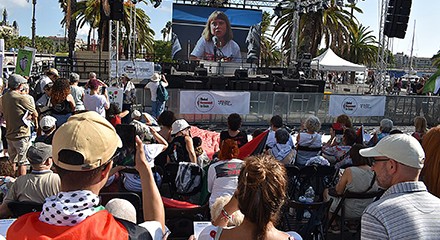09.10.2025

Millions strike for Gaza
For nearly two years the solidarity movement was fringe, small scale and politically ineffective. Not any longer. Tobias Abse reports on the mass strikes and demonstrations triggered by the Israeli attacks on the Global Sumud Flotilla. Israel is undoubtedly losing the propaganda war
Over the last fortnight there has been the greatest labour movement mobilisation in Italy of the last 20 years. This has been triggered, not by the marked decline in real wages, or any domestic issue, such as the rundown of Italy’s health service, or the sharp cuts in welfare benefits that were introduced soon after Georgia Meloni took office. No, it is the war in Gaza.
Popular reaction to what has been rightly perceived as a genocide against the Palestinians, rather than a war against Hamas, has been slower in Italy than in the UK. For a long time, the weekly demonstrations in Milan and the fortnightly ones in Rome were very small-scale affairs, largely confined to the Palestinian diaspora and small groups on the far left with a long history of support for the Palestinian cause.
Insofar as anyone else took any action, it tended to be met with massive state repression, especially against university students. Occasionally the police went so far - for instance in kettling and beating up a group of a few dozen secondary school students in Pisa in February 2024 - that wider layers took exception. However, the thousands of ordinary Pisans who took to the streets to protest against that particular local outrage did not trigger any more widespread or long-term movement.
It was not until June 7 2025 that anything that could be described as a major national demonstration over Gaza took place in Rome as a result of the parties of the parliamentary left or centre-left - the Partito Democratico (PD), Movimento Cinque Stelle (M5S) and the Alleanza Verdi Sinistra (AVS) - finally clearly coming out against the Israeli genocide. Moreover, while the June 7 march, organised by the PD, M5S and AVS, was large by Italian standards (around 50,000), it was still a lot smaller than UK demonstrations during the same period.
Naval blockade
What seems to have been the spark for recent events was the Global Sumud Flotilla. Although people from about 40 countries were involved - it aimed, of course, to break the Israeli naval blockade of Gaza - the Italian contingent was substantial, and in terms of publicity inside Italy, the involvement of four Italian parliamentarians - two from the PD, one from M5S and a Green MEP belonging to AVS - made it impossible for the mainstream media, and even the hostile Meloni government, to ignore it.
The idea of a general strike in solidarity with the flotilla and the people of Gaza was first mooted by the Unione Sindacale di Base (USB), and was more or less immediately backed up by other similar minor trade union confederations. These groups, which I would characterise as anarcho-syndicalists (even if some of their older leaders came from the autonomist tradition associated with Toni Negri), had been in the habit of calling general strikes over a variety of issues: eg, on International Women’s Day. While they sometimes manage to involve key groups of workers, such as tube drivers in Rome and Milan, such ‘general strikes’ are usually damp squibs.
Therefore, when I first saw references to the USB’s planned general strike over Gaza, I thought it was a laudable but utterly impractical plan. One of the factors that meant that, on this occasion, the anarcho-syndicalist dream became a practical reality (for one day at least) was the involvement of dockers in ports like Genoa and Livorno in plans to refuse to handle the cargo of ships carrying arms to Israel. The idea of a general strike also met with some response amongst engineering workers, including those belonging to the FIOM, the engineering workers’ union attached to the Confederazione Generale Italiana del Lavoro (CGIL), the most leftwing of the three major trade union confederations.
It was pressure from the FIOM that led Maurizio Landini - the general secretary of the CGIL, who had earlier in his career led the FIOM himself - to try to outbid the USB by calling a general strike for Friday September 19, a few days before the USB’s long-planned September 22 action. Landini’s belated call came only on September 17, and this lack of adequate notice made it impossible to call out public-sector workers without breaking the law, which is generally a matter of much more concern to the CGIL than to the wilder USB, COBAS, CUB, etc. Moreover, the instructions the CGIL gave varied according to industrial sectors and geographical regions. In some instances, workers were just told to strike for the last two hours of their shift, rather than for eight hours or even half a day.
Success
In my view, the CGIL general strike was a relative success - especially in Tuscany, where workers were called out for longer, and the participation of engineering workers in provinces like Livorno was very high. However, I will acknowledge that the USB General Strike on Monday September 22 had a greater impact, because it was accompanied by more widespread and larger demonstrations, with the USB translating the slogan of the French movement of September 8 into the Italian, ‘Blocchiamo tutto’ (‘Block everything’).
It seems probable that the bulk of the crowds on September 22 were made up of school and university students, pensioners and unemployed or irregularly employed workers, rather than wage labourers in permanent employment of the kind that would be at the heart of a conventional trade union struggle. Even the USB leaders admitted a few days later that the percentage of the workforce involved was rather small.
Significant as the two general strikes were, it was the third one, on Friday October 3, that was the most spectacular. On this occasion, the CGIL and USB buried their long-standing differences and issued a joint call for action, which was also backed by COBAS and CUB, etc. Moreover, this strike was called at very short notice, in response to the Israeli attack on the flotilla on the night of October 1.
From the moment that the news of the Israeli attack became public knowledge, thousands took to the streets all over Italy, and these spontaneous demonstrations continued the next day. Therefore, by October 3, the ranting of transport minister Matteo Salvini about the alleged illegality of the strike in sectors such as public transport was ignored, and about 60% of the entire workforce came out - quite apart from the school and university students, pensioners, unemployed and others who swelled the crowds in demonstrations in 100 cities, probably involving about two million people. On Saturday October 4, the movement continued with up to one million participating in a national demonstration in Rome, originally called by a number of Palestinian groups, the largest crowd in that city for about 20 years.1
All this - not least the involvement of thousands of workers in political demonstrations of international solidarity - is very much to be welcomed. But the question is, how can this working class politicalisation be further developed in the interests of the whole movement? l
-
The period 2001-03 was marked by a series of massive demonstrations about both trade union issues and the Iraq war.↩︎
